ALP vs GRN 7.5%
Incumbent MP
Martin Ferguson, since 1996.
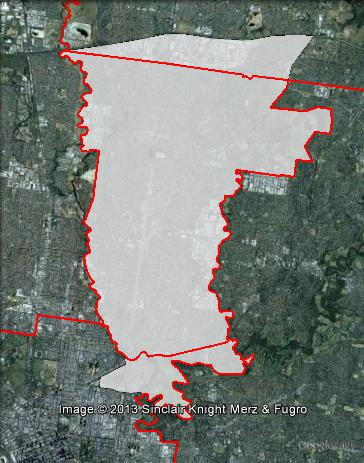
Geography
Batman covers parts of the inner north of Melbourne. Batman covers all of the City of Darebin as well as parts of Yarra and Whittlesea. Batman covers the suburbs of Fairfield, Northcote, Thornbury, Preston, Reservoir and Kingsbury.
Redistribution
Batman previously covered the entirety of Darebin. The seat expanded to cover small parts of Yarra and Whittlesea council areas. The best estimate suggests that this change reduces the Labor-Greens margin from 7.9% to 7.5%.
History
Batman is a long-standing Melbourne electorate, and for most of its history it has been held by Labor MPs.
The seat was first won in 1906 by Protectionist candidate Jabez Coon. Coon held the seat for only one term before losing it to Labor candidate Henry Beard in 1910. Beard was a former Labor state MP, and died only months after his election to the House of Representatives.
The ensuing by-election in 1911 was won by the ALP’s Frank Brennan. Brennan held the seat for the next twenty years, serving as Attorney-General in the Scullin government from 1929 until 1931. At the 1931 election Brennan lost his seat and the Scullin government was defeated, with Batman being won by UAP candidate Samuel Dennis.
Dennis only held on for one term, losing to Brennan in 1934. Brennan held the seat for another fifteen years, retiring in 1949.
Batman was won in 1949 by the ALP’s Alan Bird, a former Mayor of Northcote. Bird was re-elected throughout the 1950s, returning to the Northcote mayoralty for one year in 1958. He died in office in 1962.
The 1962 by-election was won by Williamstown mayor Sam Benson. Benson was re-elected in 1963 but in 1966 was expelled from the ALP over his support for the Vietnam War. He managed to win election as an independent in 1966. Benson retired in 1969, and the seat went to Labor candidate and Collingwood mayor Horace Garrick in 1969.
Garrick was re-elected at the 1972, 1974 and 1975 elections, but lost preselection in 1976 to Brian Howe, who won the seat at the 1977 election. Howe became a junior minister upon the election of the Hawke government in 1983, and was promoted to Cabinet following the 1984 election. Howe became Deputy Prime Minister in 1991 after Paul Keating moved to the backbench following a failed challenge to Bob Hawke’s leadership, and Howe held the position until 1995. He retired at the 1996 election.
Howe was succeeded in 1996 by former ACTU president Martin Ferguson. Ferguson went straight into the Labor shadow cabinet and was a shadow minister for the entirety of the Howard government, and joined the Cabinet in 2007 after the election of the Rudd government. Ferguson resigned from the ministry in early 2013.
Candidates
Sitting Labor MP Martin Ferguson is not running for re-election.
- Pat Winterton (Rise Up Australia)
- Ken Smithies (Family First)
- Philip Sutton (Independent)
- George Souris (Liberal)
- Lianna Sliwcynski (Sex Party)
- Alex Bhathal (Greens)
- Franco Guardiani (Palmer United Party)
- David Feeney (Labor)
- Rosemary Lavin (Animal Justice Party)
Assessment
Batman’s 7.5% margin would normally be considered safe. Labor should be able to retain the seat in current circumstances. The Greens achieved the result they gained in 2010 with Liberal preferences, which may not be forthcoming. While Batman is a seat that the Greens will be hoping to gain in the future, most of their attentions in 2013 will be focused on retaining the neighbouring seat of Melbourne.
2010 result
| Candidate | Party | Votes | % | Swing |
| Martin Ferguson | ALP | 40,574 | 52.38 | -4.80 |
| Alex Bhathal | GRN | 18,189 | 23.48 | +6.31 |
| George Souris | LIB | 15,412 | 19.90 | -0.74 |
| Andrew Conlon | FF | 2,465 | 3.18 | +0.56 |
| Con Sarazen | DEM | 823 | 1.06 | -0.97 |
2010 two-candidate-preferred result
| Candidate | Party | Votes | % | Swing |
| Martin Ferguson | ALP | 44,819 | 57.86 | |
| Alexandra Bhathal | GRN | 32,644 | 42.14 |
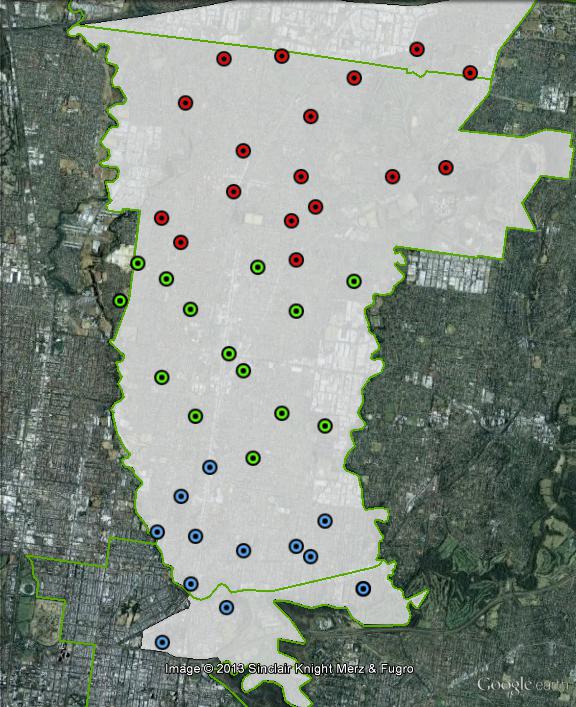
Booth breakdown
Booths have been divided into three areas: north, central and south. The southern area is centred on Northcote. The central area is centred on Preston and Thornbury. The northern area is centred on Reservoir.
The ALP won a majority in the north (65.5%) and the centre (57.9%). The Greens won a 52.4% majority in the south.
The Liberal Party’s vote varied from 15.1% in the south to 23.3% in the north.
| Voter group | LIB % | ALP 2CP % | Total votes | % of votes |
| North | 23.30 | 65.52 | 24,806 | 28.99 |
| Central | 18.49 | 57.91 | 22,387 | 26.16 |
| South | 15.05 | 47.63 | 19,885 | 23.24 |
| Other votes | 22.15 | 56.36 | 18,491 | 21.61 |
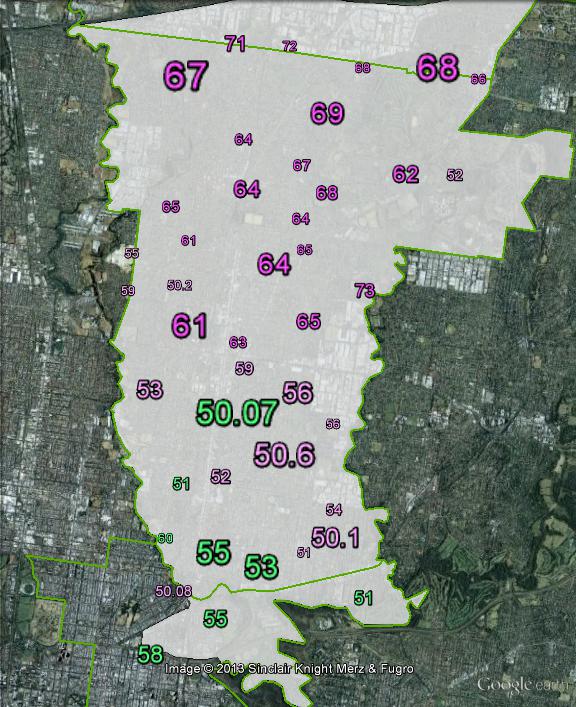
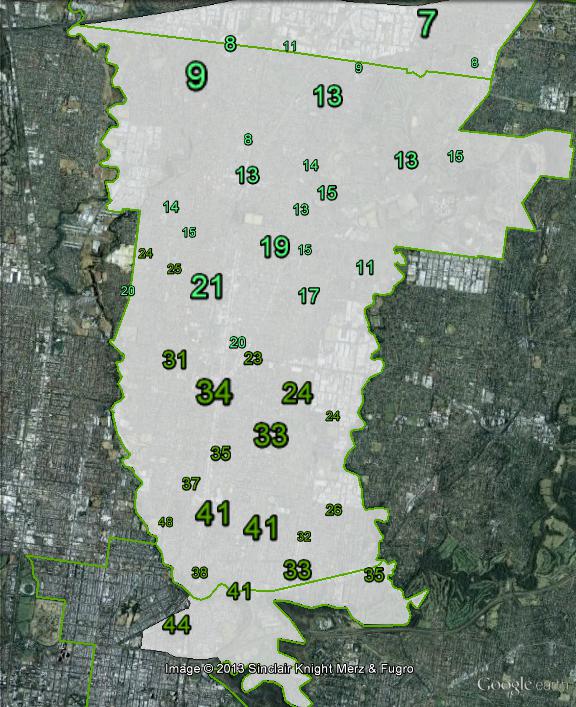
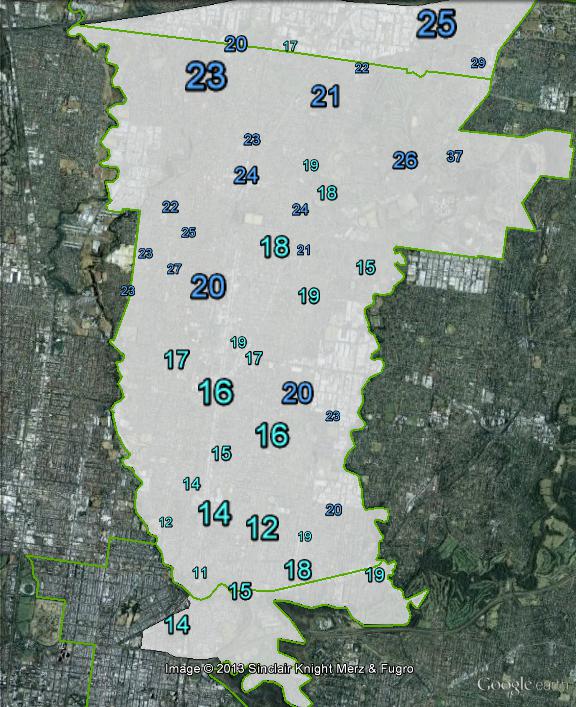


Bell Street has often been regarded as the boundary between the gentrified inner north and the more old-school Labor suburbia beyond. Gentrification has started creeping north of Bell St now, but you can still clearly see how the Green vote dies out completely halfway up the map.
The Greens will do well to make the 2PP again, but will need to wait until Preston is completely Trendy before being a serious prospect in the seat.
Well now, this becomes a bit more interesting with Martin Ferguson announcing his resignation. Although I still think “generic ALP candidate” would beat the Greens..
Would not be surprised if the Liberals still finished 2nd here. Besides, there’s probably too much “old-school Labor suburbia” here, and the Liberals (IIRC) aren’t preferencing the Greens this time around.
But it’ll be interesting to see the primary votes.
George Souris is again the Liberal candidate
http://vic.liberal.org.au/#Candidates
Feeney comfortably won the local ballot and will be the Labor candidate. I think it was roughly 350-250.
Any indication of how this seat is playing, now? Is it still going to be Labor vs Greens on 2PP? Is Labor going to get more than 50% primary?
It’ll probably end up 70/30 Labour over the Greens.
Wouldn’t be surprised if labor drops below 50% on primary vote this time around, with increases to Greens and Libs.
Safe Labor retain, Greens no chance.
Only interest here is to see whether the Liberals can take second place from the Greens.
You’d have to say that there is a distinct band of inner urban voters who are not able to elect their choice of representative. Time to draw urban electoral boundaries less like slices of pie and more like rings of an onion.
The Greens held up a lot better than I thought here, with Labor’s primary crashing.
Greens easily get 2nd here, I expected the Liberals would make it, so score that as a fail from me.
The Greens vote seemed to do well in Inner Melbourne, but they got absolutely spanked in the rest of Australia, especially in QLD, Tasmania, and most of Sydney (especially Western Sydney).
^Qld and western Syd is obviously not a surprise, even Tassie is not really a surprise – just the % drop in some places. Not really a shocked that ALPS primary dropped so much as Ferguson definitely had a much higher personal vote here than most other incumbents – perhaps upwards of 4-5%? And the 9.5% primary drop obviously spread around so much of it still came back given that the 2PP actually increased for the ALP.
To me the tactical issue for the Libs is that they could actually demoralise the ALP in seats like this by preferencing the Greens in a few specific inner city seats. Think about how depressing it would be for the ALP if they lost Batman this time and Grayndler next time due to Libs pref Greens! The ALP would start to lose it core inner city seats and thus over time every seat seems to become a battle. A sort of ‘the enemy of my enemy is my ally’ approach.
The only real downside for the Coalition would be that it undermines their PR rhetoric of ‘extreme greens’ – which didn’t really seem to work result wise this time – and that in a close election, the Greens could end up with the balance of power in the HoR with 3-4 reps. What was the LNPs strategy in Qld last election …..’cut off the head of the snake’!